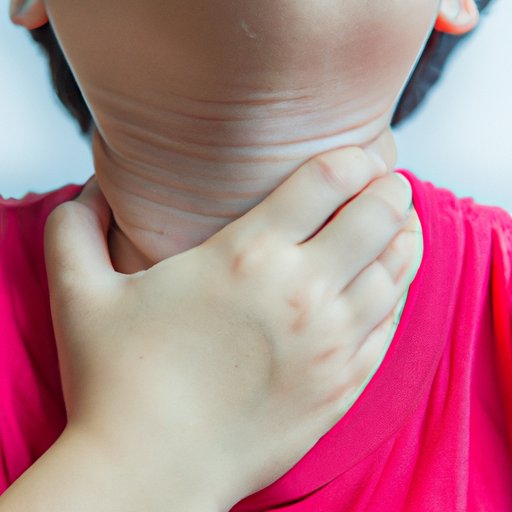Introduction
Lymph nodes are an important part of the body’s immune system, acting as filters that help to fight off infections. When they become swollen, it is often a sign of infection or other underlying health issue. In this article, we will explore what causes swollen lymph nodes, how to examine your neck, armpit, and groin area for them, and what treatments are available if you have swollen lymph nodes.
What Causes Swollen Lymph Nodes?
Swollen lymph nodes can be caused by a variety of issues, including but not limited to:
Infections
Infections such as the common cold, strep throat, mononucleosis, and HIV can cause the lymph nodes to swell. These infections usually cause the lymph nodes to swell in the neck, armpits, and groin area.
Autoimmune Diseases
Autoimmune diseases such as rheumatoid arthritis, systemic lupus erythematosus, and scleroderma can also cause swollen lymph nodes. They often cause the lymph nodes to swell in the neck, armpits, and groin area.
Cancer
Cancer can also cause the lymph nodes to swell, especially in the neck and armpit areas. A biopsy may be needed to determine if the swelling is due to cancer.
Examining the Neck Area for Swollen Nodes
The neck area is one of the most common places to find swollen lymph nodes, so it is important to check this area regularly. To do this, tilt your head back and use both hands to feel along the sides of your neck, near the collarbone. You should also check behind your ears, under your chin, and around the back of your head. Feel for any bumps or lumps that are larger than 1 cm in diameter. Swollen lymph nodes will feel like small, round lumps that move slightly when you press on them.

Feeling for Swollen Nodes in the Armpits and Groin Area
The armpits and groin area are also common locations for swollen lymph nodes. To check these areas, raise your arms above your head and then feel underneath each armpit with your fingers. You should also check the area between your legs, near your groin area. Again, feel for any bumps or lumps that are larger than 1 cm in diameter.

Common Symptoms of Swollen Lymph Nodes
If you have swollen lymph nodes, you may experience some of the following symptoms:
Tenderness
The lymph nodes may be tender to the touch.
Pain
You may experience pain in the affected area.
Heat
The area may feel warm or hot to the touch.
Redness
The area may appear red or inflamed.
Diagnostic Tests to Determine Swollen Lymph Nodes
If you suspect you have swollen lymph nodes, your doctor may order one or more of the following tests to confirm the diagnosis:
Blood Tests
A blood test can help to determine if there is an infection present. It can also detect any abnormalities in the white blood cell count that may indicate the presence of cancer.
Imaging Tests
Imaging tests such as X-rays, CT scans, and MRIs can help to identify any enlarged lymph nodes, as well as any other abnormalities in the area.
Biopsy
If the imaging tests reveal any suspicious lymph nodes, your doctor may recommend a biopsy to determine if the swelling is due to cancer.
Treatment Options for Swollen Lymph Nodes
Treatment for swollen lymph nodes depends on the underlying cause. Treatment options include:
Antibiotics
If the cause is an infection, antibiotics may be prescribed to treat the infection.
Surgery
In some cases, surgery may be necessary to remove the infected or abnormal lymph nodes.
Radiation Therapy
Radiation therapy may be used to shrink or destroy cancerous lymph nodes.

When to Seek Medical Attention for Swollen Lymph Nodes
It is important to seek medical attention if your symptoms persist despite at-home treatments, if the lymph nodes are red, hot, or tender, or if the lymph nodes are larger than 2 cm. Your doctor will be able to diagnose the underlying cause and provide the appropriate treatment.
Conclusion
Swollen lymph nodes can be a sign of many different conditions, ranging from minor infections to more serious illnesses such as cancer. While some cases may resolve on their own, it is important to seek medical attention if the symptoms persist or worsen. By examining the neck, armpit, and groin area for any lumps or bumps that are larger than 1 cm in diameter, and being aware of the common symptoms of swollen lymph nodes, you can help to ensure that any underlying health issues are identified and treated promptly.
(Note: Is this article not meeting your expectations? Do you have knowledge or insights to share? Unlock new opportunities and expand your reach by joining our authors team. Click Registration to join us and share your expertise with our readers.)
